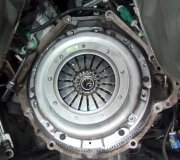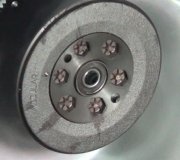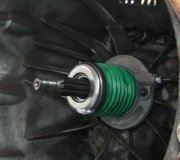There are a few things that could be happening.
First, do you feel the shifter move, "Further into gear" when you release the clutch?
Does it make any grinding noises or anything harsh like that?
If it does not then that is a good sign that the internals may be OK. But, they cannot be ruled out either.
One suggestion here would be to replace the oil in the transmission. When you do so, use a really clean drain pan. When you get most of the oil pored into a milk jug or whatever container you might use to transport it, leave a little bit in the drain pan. Either take it out in the sun or under a strong light. Look for the glint of tiny metal specks or shavings. Some may look dull, some silver and some a brass color. This metal will settle out of the oil you drain out slowly so let the time you take to drain it into a waste container sit a while.
The amount, size and color(Type) of metal in the oil can give you an idea of the condition of the internals of the transmission.
The other thing to check will be the clutch system.
Does the clutch slip at any other time?
I think you have a hydraulic clutch which means that when you press the clutch pedal, a system much like the brake system in your car uses brake fluid to push on the clutch pressure plate to dis-engage the clutch.
So, the first thing to check would be the fluid level. There is a small master cylinder next to the larger brake master cylinder in the engine compartment on the drivers side. Check the fluid level and general condition of the fluid. It is nearly clear when new. Clutch fluid gets dirtier faster than any other fluid except engine oil. I don't think manufacturers suggest flushing it enough as it does not take a lot of fluid and it would increase its service life, but they don't.
From the master cylinder there is a hose that connects to the slave cylinder which is usually on the outside of the transmission cases in the front of the motor. It acts as the piston that actually pushes the fluid into the pressure plate or clutch arm and dis-engages the clutch. It is built much like a master cylinder and can have the same issues. If you have ever worked with bleeding a brake system, you will find a small bleed screw on this part. This pushes a push-rod into a lever arm which in turn pushes throw out bearings to release the pressure off the clutch by dis-engaging the pressure plate.
Some issue that can happen here are lack of lubrication on the lever arm pivot point, the slave cylinder not operating smoothly, the throw out bearings failing, the pilot bearing failing or a leak in the fluid transfer hose.
The possible things that could be causing the issue;
There is air in the system, not very likely since it goes into first pretty well.
The master cylinder is failing or needs to be flushed and have the fluid changed so it will operate smoothly.
The same could be true of the slave cylinder or it could be a compounding of the two making the whole system less smooth to the feel and can cause it to stick when being released.
The hydraulic hose could have a leak, not likely but worth checking.
The pressure plate springs are not engaging properly.
The throw-out bearings are failing. This is not very likely as it usually will make noise.
Pilot bearing failure.
My suggestion to cheaply service the clutch system and get an idea if doing affects the problem.
Get a quart or two of DOT 3 or 4, check your owners manual for clutch fluid, but it will probably call for a DOT 3-4.
Get a clean easy to see through plastic bottle that holds around a liter or so and has a cap to contain dirty fluid. Find the bleed screw on the slave cylinder. Go to your local hardware store and get a few feet of clear pliable poly vinyl or equivalent tubing. That fits snuggly over the bleed nipple end.
You want to get a good wrench the loosen and tighten the bleed screw as damaging it will cause a whole other problem. Buy some WD40 or PB Blaster and spray it liberally on the bleed screw. Then wipe of the residue. Repeat this and let it soak overnight. Doing this helps to ensure the bleed screw loosens easily without slipping. Get some Brake Cleaner and some rags or paper towels to clean the bleed screw before bleeding the system.
If you have some heavy axle grease or can get some, apply it liberally to the threads of the bleed screw. This keeps air from entering the system.
Make sure the hose you bought fits tightly over the bleed screw and is long enough to go over something higher than the bleed screw and come back down into the catch bottle and go all the way to the bottom. This is going to catch all the fluid you flush through the system and help to expel any air that may be in it.
You will need an assistant to pump the clutch pedal several times and then hold it to the floor.
First, try to remove some fluid from the master cylinder reservoir with a paper towel. However, do not allow the level to reach the bottom of the cup. You will see a hole at the bottom of the reservoir cup and if any air gets into that hole, it will have to be pushed through the entire system. So, it is important to watch this cup carefully during this process so the level never gets low. Fill the cup. Put the matching wrench, a closed ended 6 point wrench is best, which is usually a 6or 8 mm and put it on so that you will have room to move it to loosen, turn counter clockwise, to open the bleeder. Attach the hose to the bleeder and run it in the aforementioned way to the catch bottle.
Have your assistant, pump and hold the pedal, carefully loosen the bleeder until fluid comes out, tighten it, and then the assistant can release the pedal. If the pedal is released before the bleeder is closed tight, air will get into the system.
Repeat the pump and hold fluid flush until fluid has spilled over the highest point in the tube. If you have not, put axle grease on the threads of the bleed screw threads.
Continue to flush fluid in the same manner. Keep doing so until the fluid comes out clean. If you want to really flush the system, you can leave the bleeder just loose enough to allow fluid to pass and have your assistant just pump the clutch pedal as you keep the reservoir full. If you don't have axle grease on the bleeder threads, you may have to expel some air before your done, so save fluid.
Once fluid is coming out clean and without any air bubbles in it, tighten the bleed screw and have your assistant pump and hold one last time with the next tightening of the bleeder being good enough to keep it closed. Remove the tube and let fluid drain into the bottle. Check master cylinder fluid level and fill accordingly.
Now watch the push rod and the clutch lever arm to see if there is any motion that seems un-aligned or binds when using clutch pedal. Check for leaks.
Test the car and see if there is a difference in the way it shifts. The master cylinder and/or the slave cylinders still could be failing, so if there is little change you have not wasted the fluid completely as the fluid hose must be flushed clean before replacing components.
So, replace the transmission oil and look for metal.
Service the clutch hydraulic system and see what affect it has on system.
Inspect clutch system.
See how this goes and let me know. The next step will depend on the outcome. Master cylinders and slave cylinders can be purchased from a good re-manufacturer for under $50+ delivered with all new seals and push rod.
I will watch for your reply and get back to you ASAP.
Wednesday, November 9th, 2011 AT 4:16 AM


